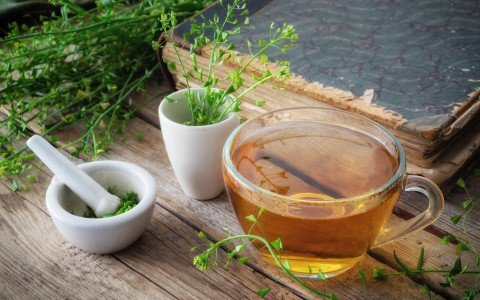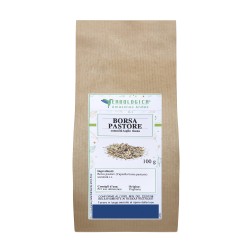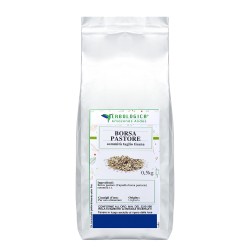
La borsa del pastore è un'erba sorprendente e versatile con molti usi e benefici che la rendono un'ottima aggiunta a qualsiasi giardino.
Questa pianta perenne e resistente è originaria di alcune zone dell'Europa e dell'Asia, ma può essere coltivata in qualsiasi clima temperato.
È una pianta incredibilmente facile da coltivare e mantenere, e può essere raccolta in natura o coltivata in giardino.
Ha una lunga storia di usi medicinali ed è nota per la sua capacità di aiutare a trattare disturbi come problemi digestivi, infezioni della pelle.
È anche commestibile e le sue foglie e i suoi semi possono essere utilizzati in cucina.
Non solo la pianta della borsa del pastore è incredibilmente utile e benefica, ma è anche una bellissima aggiunta a qualsiasi giardino, con i suoi fiori gialli brillanti e il fogliame verde.
Di conseguenza, sta diventando sempre più popolare tra i giardinieri che desiderano aggiungere una pianta splendida e utile al loro spazio.
Cos'è la borsa del pastore?
La borsa del pastore è un'erba sorprendente con fiori gialli e fogliame verde.
È una pianta perenne originaria di alcune zone dell'Europa e dell'Asia, ma può essere coltivata in qualsiasi clima temperato.
Ha una lunga storia di usi medicinali ed è nota per la sua capacità di aiutare a trattare disturbi come problemi digestivi, infezioni della pelle
La pianta è anche commestibile e le sue foglie e i suoi semi possono essere utilizzati in cucina.
Il nome scientifico della borsa del pastore è Capsella bursa-pastoris.
È un membro della famiglia delle Brassicaceae, che comprende cavoli, senape e cavolo.
Il nome della pianta deriva dalla forma dei suoi semi, che ricordano una borsa o un borsello da pastore.
La borsa del pastore è una pianta annuale a crescita rapida che può raggiungere un'altezza di 24 pollici.
Ha fiori gialli brillanti che sbocciano in primavera e piccole foglie verdi.
È un'erba facile da mantenere che può essere raccolta in natura o coltivata in giardino.
Storia e usi della borsa del pastore
La borsa del pastore è stata usata per secoli a scopo medicinale.
È stata documentata per la prima volta dagli antichi Greci e Romani, che la usavano per trattare problemi digestivi, infezioni della pelle
Veniva utilizzato anche come trattamento topico per le infezioni della pelle e le ferite.
Nella medicina tradizionale cinese, la borsa del pastore veniva utilizzata per trattare una serie di disturbi, tra cui febbre, nausea, dolore addominale e diarrea.
Veniva usata anche per trattare condizioni della pelle come eczema e psoriasi e si riteneva che avesse proprietà antinfiammatorie e analgesiche.
La borsa del pastore è anche commestibile.
Le sue foglie possono essere consumate crude o cotte, mentre i suoi semi possono essere arrostiti e macinati in polvere.
La polvere può essere utilizzata come sostituto del sale e può essere aggiunta a zuppe e stufati per aggiungere sapore e nutrimento.
Benefici della borsa del pastore per la salute
La borsa del pastore è una pianta incredibilmente nutriente, ricca di vitamine, minerali e antiossidanti.
È una ricca fonte di vitamina C e di altri antiossidanti che possono aiutare a proteggere dai danni dei radicali liberi e dallo stress ossidativo.
È anche una buona fonte di fibra alimentare, che può aiutare a sostenere una sana digestione e a promuovere la regolarità.
Si ritiene che la borsa del pastore abbia anche una serie di proprietà medicinali che possono aiutare a trattare una serie di disturbi.
Si ritiene che abbia proprietà antinfiammatorie e analgesiche che possono aiutare a ridurre il gonfiore, il dolore e l'infiammazione.
Si ritiene inoltre che abbia proprietà antimicrobiche che possono aiutare a combattere batteri e virus.
Si ritiene che la borsa del pastore abbia anche proprietà antitumorali.
Alcuni studi hanno dimostrato che i composti presenti nella pianta possono contribuire a inibire la crescita delle cellule tumorali e potrebbero persino essere in grado di ucciderle.
Coltivare la borsa del pastore in giardino
La borsa del pastore è una pianta incredibilmente facile da coltivare e mantenere.
Può essere coltivata in qualsiasi clima temperato e prospera in pieno sole o in ombra parziale.
Preferisce un terreno ben drenato e ricco di materia organica, come compost o letame marcio.
Per propagare la borsa del pastore, è sufficiente spargere i semi sulla superficie del terreno e coprirli leggermente con la terra.
Innaffiare abbondantemente l'area e mantenerla umida fino alla germinazione dei semi, che di solito avviene in una settimana.
Una volta che le piantine sono spuntate, diradatele per dare loro spazio di crescita.
La borsa del pastore può essere propagata anche per divisione.
È sufficiente scavare la pianta e dividerla in più sezioni, ognuna con qualche stelo e radici.
Piantate le divisioni in una nuova posizione e annaffiatele abbondantemente.
Raccolta e conservazione della borsa del pastore
La borsa del pastore può essere raccolta in natura o coltivata in giardino.
Se viene raccolto in natura, è importante che venga raccolto solo in aree non contaminate da sostanze inquinanti o chimiche.
Una volta raccolta, la borsa del pastore può essere conservata tramite essiccazione o congelamento.
Per essiccare l'erba, stendete le foglie e i fiori su un telo e metteteli in un luogo caldo e asciutto.
Una volta secchi, le foglie e i fiori possono essere conservati in un contenitore ermetico.
Per congelare l'erba, stendere le foglie e i fiori su una teglia e metterli in freezer.
Una volta congelati, trasferire le foglie e i fiori in un sacchetto o in un contenitore sicuro per il congelamento.
Come cucinare con la borsa del pastore
La borsa del pastore è un'erba incredibilmente versatile che può essere utilizzata in una varietà di piatti.
Le sue foglie e i suoi semi possono essere utilizzati freschi o essiccati e possono essere aggiunti a zuppe, stufati, insalate e altri piatti per aggiungere sapore e nutrimento.
Le foglie possono essere tritate e aggiunte alle insalate o cucinate in zuppe e stufati.
I semi possono essere tostati e macinati in una polvere che può essere usata come sostituto del sale.
La polvere può essere utilizzata anche per insaporire il curry e altri piatti.
Le foglie e i fiori possono essere utilizzati anche per preparare il tè.
È sufficiente mettere in infusione le foglie e i fiori in acqua calda per qualche minuto e filtrare.
Il tè può essere gustato caldo o freddo e, se si desidera, può essere addolcito con miele o zucchero.
Ricette per la cura della pelle con la borsa del pastore
La borsa del pastore è un'erba incredibilmente versatile che può essere utilizzata per realizzare una varietà di prodotti per la cura della pelle.
Le sue foglie e i suoi fiori possono essere utilizzati per fare uno scrub lenitivo per il viso o una maschera nutriente per il viso.
Per preparare uno scrub per il viso, è sufficiente mescolare un cucchiaio di foglie di borsa del pastore finemente macinate, un cucchiaio di avena macinata e un cucchiaio di miele.
Massaggiare il composto sul viso con movimenti circolari, quindi risciacquare con acqua tiepida.
Per preparare una maschera nutriente per il viso, mescolare un cucchiaio di foglie di borsa del pastore finemente macinate, un cucchiaio di miele e un cucchiaio di yogurt.
Applicare il composto sul viso e lasciarlo agire per 10 minuti prima di risciacquare con acqua tiepida.
La borsa del pastore nella medicina tradizionale
La borsa del pastore ha una lunga storia di utilizzo nella medicina tradizionale.
Nella medicina tradizionale cinese, l'erba veniva utilizzata per trattare una serie di disturbi, tra cui febbre, nausea, dolori addominali e diarrea.
Veniva anche utilizzata per trattare condizioni della pelle come eczema e psoriasi e si riteneva che avesse proprietà antinfiammatorie e analgesiche.
La borsa del pastore è utilizzata anche nella medicina moderna per trattare una serie di disturbi, tra cui problemi digestivi e infezioni della pelle.
Si usa anche per via topica per ridurre il gonfiore, il dolore e l'infiammazione.
Considerazioni sulla sicurezza nell'uso della borsa del pastore
Sebbene la borsa del pastore sia generalmente sicura da usare, ci sono alcune considerazioni di sicurezza da tenere a mente.
L'erba può causare irritazioni cutanee in alcune persone, quindi è importante testare una piccola area della pelle prima di usarla per via topica.
Le persone in gravidanza o in fase di allattamento dovrebbero evitare di utilizzare l'erba, in quanto potrebbe causare effetti negativi.
È inoltre importante acquistare la borsa del pastore da una fonte affidabile.
Assicuratevi di acquistare l'erba da un'azienda che testa i propri prodotti per verificarne la purezza e la sicurezza.
Conclusioni
La borsa del pastore è un'erba incredibilmente versatile e benefica che vanta una lunga storia di usi medicinali.
Può essere usata per trattare una varietà di disturbi, dai problemi digestivi alle infezioni della pelle.
È anche commestibile e le sue foglie e i suoi semi possono essere utilizzati in cucina.
La borsa del pastore non solo è una pianta incredibilmente utile e benefica, ma è anche una bella aggiunta a qualsiasi giardino con i suoi fiori gialli e il suo fogliame verde.
Di conseguenza, sta diventando sempre più popolare tra i giardinieri che desiderano aggiungere una pianta bella e utile al loro spazio.



